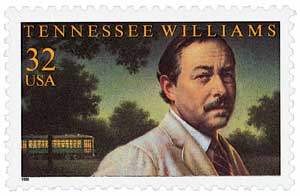
# 3186n FDC - 1999 33c Celebrate the Century - 1940s: "A Streetcar Named Desire" - Broadway Hit 1947
Â
33¢ A Streetcar Named Desire
Celebrate the Century – 1940s
City: Dobbins AFB, GA
Printing Method: Lithographed, engraved
Perforations: 11.5
Color: Multicolored
Birth Of Tennessee Williams
The second of three children, Williams was struck with diphtheria as a child and nearly died. The yearlong recuperation left him frail, which upset his father, a descendant of hardy Tennessee pioneers. Williams would later base much of his writing on his dysfunctional family and childhood. Â
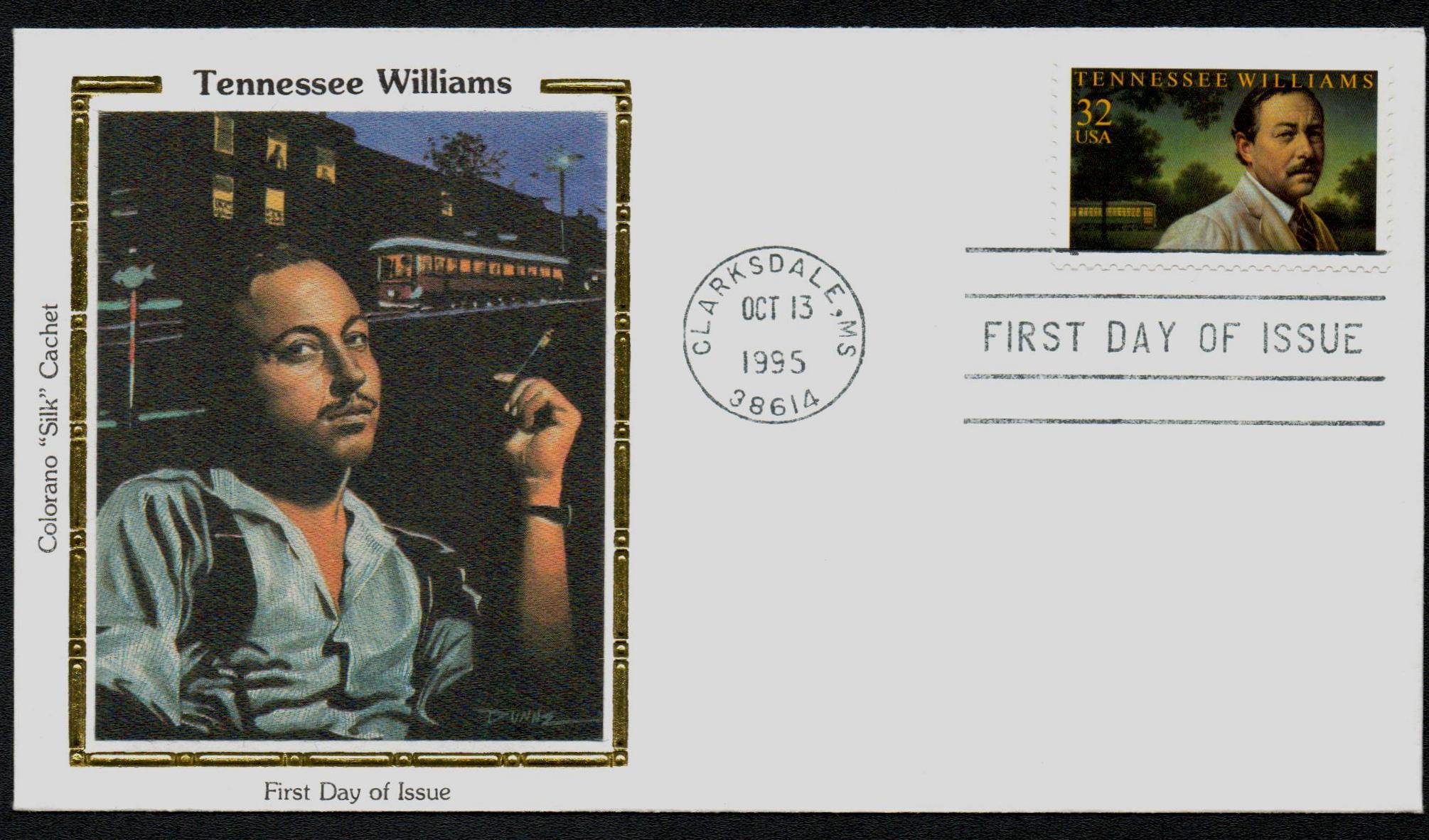
The family moved around St. Louis, Missouri, several times during Williams’ childhood. When he was 16, his essay “Can a Good Wife Be a Good Sport?†won third place in a contest. The following year, his short story “The Vengeance of Nitocris†was published in Weird Tales magazine.
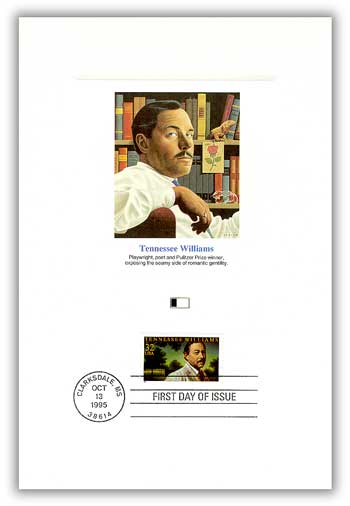
Williams attended the University of Missouri where he studied journalism. In his spare time, he wrote poetry, essays, stories, and plays for contests to make money. His play Beauty is the Word, received an honorable mention, making him the first freshman to receive that honor.
Williams’ father removed him from school after just two years to make him work at a shoe factory. Williams hated the job but resolved to write even more, spending his nights and weekends producing a story a week. However, by the time he was 24, Williams was overworked and depressed and quit his job. (This period would later serve as inspiration for Stanley Kowalski in A Streetcar Named Desire.)
Williams decided to resume his education first at Washington University in St. Louis and then the University of Iowa. After graduating, Williams went on to study at the Dramatic Workshop in New York City. He adopted the name “Tennessee Williams†around 1939.
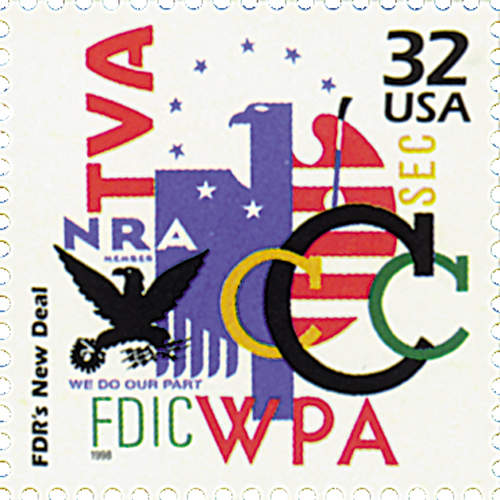
While waiting for his big break as a writer, Williams worked a series of odd jobs, including as a caretaker on a chicken ranch. His first professional production was Battle of Angels. For that work, he received a Rockefeller Foundation grant for $1,000, which he used to move to New Orleans in 1939. While there he worked as a writer for Roosevelt’s Works Progress Administration (WPA). Around this time, Hollywood took note of his Rockefeller grant and he received a six-month contract with Metro Goldwyn Mayer.
In 1944, Williams had another major break – his play The Glass Menagerie debuted in Chicago to positive reviews. When the play moved to New York it became a huge hit and made Williams famous. Combining semiautobiographical material with innovative stage techniques, this play won a New York Drama Critics’ Circle Award for best play of the season.
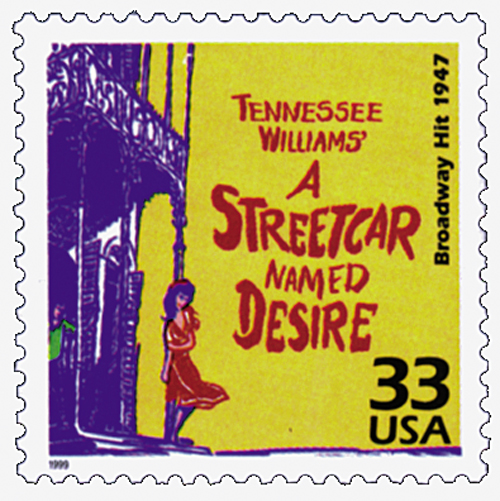
Williams had another major hit just a couple years later with the Pulitzer Prize-winning A Streetcar Named Desire. Despite his success, Williams was restless and believed he needed to move often for inspiration. As he explained it, “Only some radical change can divert the downward course of my spirit, some startling new place or people to arrest the drift, the drag.â€
Over the next decade, seven more of Williams’ plays appeared on Broadway: Summer and Smoke (1948), The Rose Tattoo (1951), Camino Real (1953), Cat on a Hot Tin Roof (1955), Orpheus Descending (1957), Garden District (1958), and Sweet Bird of Youth (1959). He earned another Pulitzer, two more New York Drama Critics Circle Awards, three Donaldson Awards, and a Tony. Several of his plays were also made into movies.
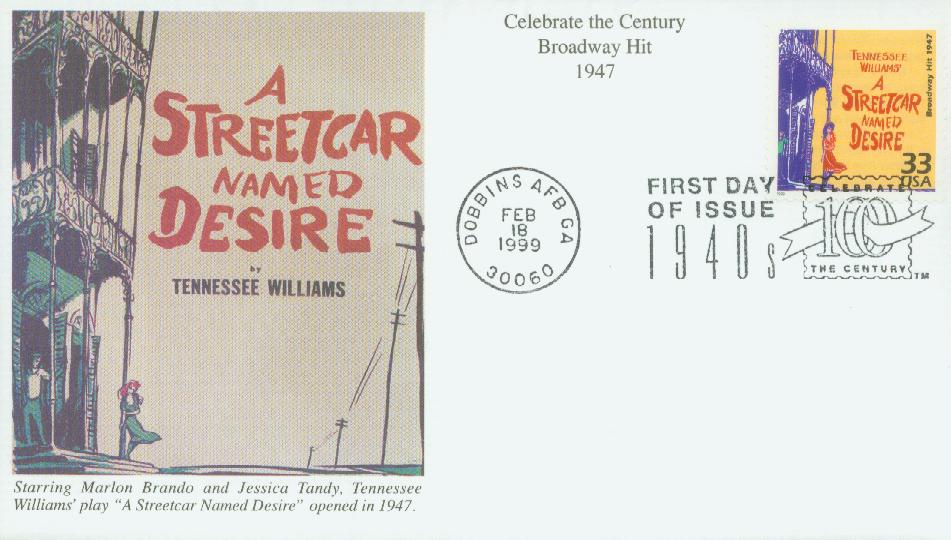
Williams’ work of the 1960s and 70s was not as well received and his popularity waned. He died on February 25, 1983, in New York City.
Click here to read some of Williams’ poetry.
Â
Â
Â
33¢ A Streetcar Named Desire
Celebrate the Century – 1940s
City: Dobbins AFB, GA
Printing Method: Lithographed, engraved
Perforations: 11.5
Color: Multicolored
Birth Of Tennessee Williams
The second of three children, Williams was struck with diphtheria as a child and nearly died. The yearlong recuperation left him frail, which upset his father, a descendant of hardy Tennessee pioneers. Williams would later base much of his writing on his dysfunctional family and childhood. Â

The family moved around St. Louis, Missouri, several times during Williams’ childhood. When he was 16, his essay “Can a Good Wife Be a Good Sport?†won third place in a contest. The following year, his short story “The Vengeance of Nitocris†was published in Weird Tales magazine.

Williams attended the University of Missouri where he studied journalism. In his spare time, he wrote poetry, essays, stories, and plays for contests to make money. His play Beauty is the Word, received an honorable mention, making him the first freshman to receive that honor.
Williams’ father removed him from school after just two years to make him work at a shoe factory. Williams hated the job but resolved to write even more, spending his nights and weekends producing a story a week. However, by the time he was 24, Williams was overworked and depressed and quit his job. (This period would later serve as inspiration for Stanley Kowalski in A Streetcar Named Desire.)
Williams decided to resume his education first at Washington University in St. Louis and then the University of Iowa. After graduating, Williams went on to study at the Dramatic Workshop in New York City. He adopted the name “Tennessee Williams†around 1939.

While waiting for his big break as a writer, Williams worked a series of odd jobs, including as a caretaker on a chicken ranch. His first professional production was Battle of Angels. For that work, he received a Rockefeller Foundation grant for $1,000, which he used to move to New Orleans in 1939. While there he worked as a writer for Roosevelt’s Works Progress Administration (WPA). Around this time, Hollywood took note of his Rockefeller grant and he received a six-month contract with Metro Goldwyn Mayer.
In 1944, Williams had another major break – his play The Glass Menagerie debuted in Chicago to positive reviews. When the play moved to New York it became a huge hit and made Williams famous. Combining semiautobiographical material with innovative stage techniques, this play won a New York Drama Critics’ Circle Award for best play of the season.

Williams had another major hit just a couple years later with the Pulitzer Prize-winning A Streetcar Named Desire. Despite his success, Williams was restless and believed he needed to move often for inspiration. As he explained it, “Only some radical change can divert the downward course of my spirit, some startling new place or people to arrest the drift, the drag.â€
Over the next decade, seven more of Williams’ plays appeared on Broadway: Summer and Smoke (1948), The Rose Tattoo (1951), Camino Real (1953), Cat on a Hot Tin Roof (1955), Orpheus Descending (1957), Garden District (1958), and Sweet Bird of Youth (1959). He earned another Pulitzer, two more New York Drama Critics Circle Awards, three Donaldson Awards, and a Tony. Several of his plays were also made into movies.

Williams’ work of the 1960s and 70s was not as well received and his popularity waned. He died on February 25, 1983, in New York City.
Click here to read some of Williams’ poetry.
Â
Â






